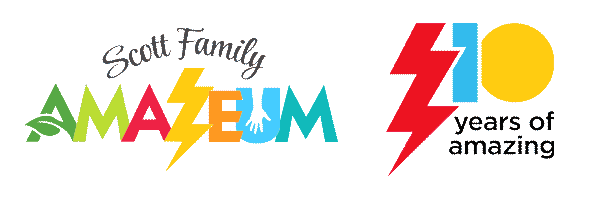Messy Learning Comes Naturally
by: Bailey Thompson
Don’t be afraid to get your hands dirty.
That is what you may have been told when it comes to doing something like gardening and other work. Here at the Amazeum, we take that phrase literally, especially with regard to play and learning.
This summer, you may find yourself in the middle of a forest inside the Amazeum when you enter Forever Forest, a national traveling exhibit on loan from the Omaha Children’s Museum that explores how we use the forest to live, work, and play in harmony. And sometimes the forest is a little messy.
Our Play Facilitators were asked to create a pop-up activity inspired by Forever Forest. That’s where Mud Painting comes in. Mud offers so many important aspects for children to experience during early childhood. It offers a unique sensory activity because it is soft and malleable. Mud and other natural materials give children the opportunity to create something colorful and unique with natural materials that open a whole new world of creativity and exploration. Mud activities use almost all of the senses - touch, sound, sight, and smell. It offers multiple sensory experiences in one activity. When children measure and mix the “paint”, they learn science and math concepts.
The Ph.D. in Mudology behind all this is Play Facilitator Haley Gastineau. When she was presented with the challenge of creating a completely original pop-up experience, she knew she wanted to do something that was both messy and creative. Great experiences begin with great questions, so she asked, “I wonder if we could paint with mud?” After doing some research, Haley found that the process was easier than she originally thought.
Dirt, water, washable paint, and a little bit of dish soap is all you need. It really was all about sensory play exploration, which is a vital piece of the early childhood experience. Through sensory play, children’s language and motor skills are developed, and it also encourages problem-solving and critical thinking. She enjoyed exploring how texture impacts the pop-up. “There’s always going to be clumps in it, but it adds texture to your painting,” Hayley said.
Haley first began applying the paint using a regular paint brush to regular paper, but that simply wasn’t “Amazeum” enough for her. She investigated alternative paintbrushes and came up with her favorite aspect of the Mud Painting pop-up: natural elements sourced from the forest nearby the Amazeum grounds. Haley found evergreen limbs on the ground just off a walking trail at the nearby Crystal Bridges Museum of American Art. Collecting sticks that weren’t very pliable, Haley wrapped pine needed around the sticks and tied it all together with string. While prototyping this pop-up, she noticed the natural paint brushes alone were a bit of a draw for some kids. “They’d walk up and ask ’What are these?’ and I’d follow up by asking them if they recognize any of the material," Haley said. "They’d respond with ’ This is from a pine tree!’" By asking the guests if they know what the material is before giving away the answer, guests will begin to think about the materials in different ways.
 You may first notice this pop-up because kids are painting on the ground. As the weather has warmed up, many of our pop-ups are being held in our Outdoor Playscape. The Mud Painting pop-up is so simple to clean up, that if you apply the paint to the ground, rain will simply wash it all away. That’s right, Mud Painting is done on a variety of Amazeum inspired surfaces, like rocks, tree bark, Plexiglas, even concrete. While some parents may be apprehensive about their child playing with both paint and mud, we do provide smocks just in case you’d rather enjoy all the fun without the possibility of getting mud stuck to clothing. But, remember messy learning is learning that sticks.
You may first notice this pop-up because kids are painting on the ground. As the weather has warmed up, many of our pop-ups are being held in our Outdoor Playscape. The Mud Painting pop-up is so simple to clean up, that if you apply the paint to the ground, rain will simply wash it all away. That’s right, Mud Painting is done on a variety of Amazeum inspired surfaces, like rocks, tree bark, Plexiglas, even concrete. While some parents may be apprehensive about their child playing with both paint and mud, we do provide smocks just in case you’d rather enjoy all the fun without the possibility of getting mud stuck to clothing. But, remember messy learning is learning that sticks.
Look for Mud Painting pop-up in Forever Forest, outside in the Playscape, in locations around the museum all summer long.







